Fault Code 42: Splitter Failed to Engage
J1587: MID 130 SID 37 FMI 7
MID 130 SID 38 FMI 7
J1939: SA 3 SPN 770 FMI 7
SA 3 SPN 771 FMI 7
Overview
The UltraShift PLUS LSE, MHP, MXP, VCS, VHP, VMS and VXP series transmissions are equipped with a 2-speed splitter system in the auxiliary case. The splitter system uses a reduction gear to increase the total number of gear ratios available to the transmission. It also reduces the gear ratio step-sizes between shifts by using the main case gearing once in auxiliary low split and then again in auxiliary high split. The system can use the reduction gear to allow the transmission to operate at very low speeds (or creep) applications.
The splitter system is equipped with a Splitter Solenoid Valve. The Splitter Solenoid Valve is an electric-over-air solenoid that is controlled by the Transmission Electronic Control Unit (TECU), replacing the Shift Knob-Splitter Button system found on Eaton Cummins Automated Transmissions.
During operation, the solenoid directs air pressure to either port in the Splitter Cover based on the need to activate the auxiliary low split or high split gearing. The applied air pressure directs the fore-and-aft movement of the Splitter Piston within the Splitter Cylinder, facilitating the mechanical engagement of either low or high split position. Fault Code 42 indicates that the transmission is unable to complete a split shift.
Detection
When toggling the Splitter Solenoid Valve, the TECU verifies the new splitter position by calculating the overall transmission gear ratio, using the Main Shaft and Output Shaft Speed Sensor signals. If the calculated ratio does not match the expected ratio for the new splitter position, the auxiliary case gearing did not change as expected, and the TECU sets the fault Active.
The TECU detected a system failure, but was unable to detect the specific root cause.
Conditions to Set Fault Code Active
FMI 7 – Mechanical System Not Responding: The transmission is either stuck in its current splitter position or it cannot engage the desired splitter position after five consecutive attempts.
Fallback
FMI 7
- Transmission remains in the splitter state where the failure occurred.
- Transmission may attempt to shift into low split when the vehicle comes to a stop.
- Until the fault becomes Inactive, driver may have to shut off engine with transmission in gear.
Conditions to Set Fault Code Inactive
FMI 7: Transmission successfully attains the requested splitter position for 2 seconds.
Possible Causes
FMI 7
- Vehicle Air System
- Low vehicle air pressure
- Contamination in air supply
- Air leaks
- Filter-Regulator failure
- Splitter Solenoid Valve
- Mechanical failure
- Mechanical Transmission
- Splitter Cylinder, Piston, or Yoke wear or damage
- Splitter Cover Gasket failure
- Tone Wheel damage
- Failed auxiliary case components
- Main Shaft Speed Sensor
- Internal failure
- Output Shaft Sensor
- Internal failure
Additional Tools
- Two 0–100 PSI Air Pressure Gauges
- 0–150 PSI Air Pressure Gauge
Component Identification
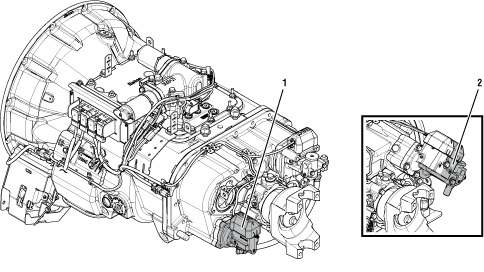 |
1. Splitter Solenoid Valve (MHP / VHP / MXP / LSE / VXP) 2. Splitter Solenoid Valve (VCS / VMS) |
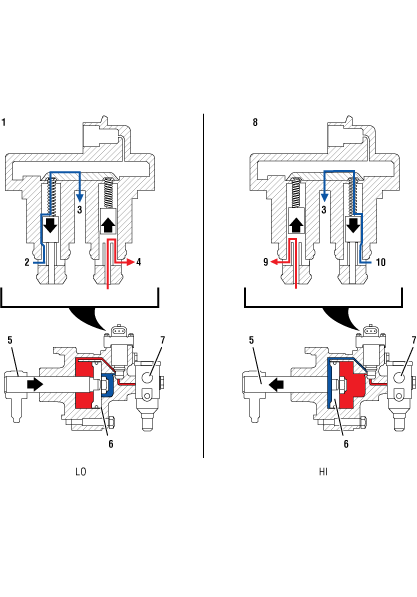 |
1. Splitter Solenoid Valve (LO) 2. Cylinder Port (Exhaust) 3. Exhaust Port 4. Regulated Port (Air) 5. Shift Yoke 6. Piston 7. Filter-Regulator 8. Splitter Solenoid Valve (HI) 9. Regulated Port (Air) 10. Cylinder Port (Exhaust) |
Fault Code 42 Troubleshooting
Record the transmission fault codes, FMIs, occurrences, and timestamps from the Service Activity Report created during the Diagnostic Procedure.
If Fault Code 42 FMI 7 is Active or Inactive, go to TAIB-0999 Fault Code 41 and/or 42 Due to a Restricted Range/Splitter Exhaust Port.
If Fault Code 42 FMI 7 is Active or Inactive, and Fault Codes 46, 57 or 58 are not set and Splitter Exhaust Port is not restricted, Go to Step B
Key off.
Set parking brake and chock wheels.
Vent vehicle air supply tanks.
CautionInstall a 0–150 PSI air pressure gauge between the supply line and the Air Filter-Regulator located at the back of the transmission.
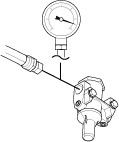
Key on, engine running.
Allow air pressure to rise to governor cut off.
Key off.
Monitor air pressure at gauge on supply line for 1 minute. Record reading(s) in table.
If readings are in range and the vehicle is able to maintain pressure, Go to Step C
If readings are out of range or the vehicle can not hold pressure, repair vehicle air system per OEM guidelines. Go to Step V
| Model | Pressure | Reading(s) |
|---|---|---|
| All Models | 90–120 PSI |
Key off.
Vent vehicle air supply tanks.
CautionInstall a 0–100 PSI air pressure gauge into a regulator test port of the Air Filter-Regulator.
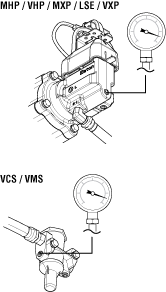
Key on with engine running.
Allow air pressure to build to governor cut off.
Key off.
Monitor air pressure and record reading(s) in table.
Compare reading(s) in table.
If air pressure is in range, Go to Step D
If air pressure is out of range, replace Air Filter-Regulator. Go to Step V
| Model | Pressure | Reading(s) |
|---|---|---|
| All Models | 55–65 PSI |
Key off.
Vent vehicle air supply tanks.
CautionInstall a 0–100 PSI air pressure gauge into each of the splitter cover diagnostic ports (L and H).
Caution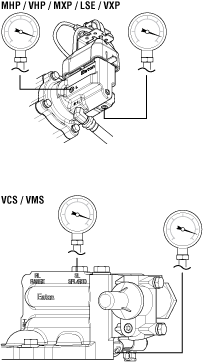
Key on with engine running.
Allow air pressure to build to governor cut off.
Key on with engine off.
CautionDepress the Service Brake pedal and using the shift device, engage Reverse 1 (R1). Record air pressure reading of low-split pressure gauge in the table.
Depress the Service Brake pedal and using the shift device, button up shift to Reverse 2 (R2). Record air pressure reading of high-split pressure gauge in table.

Note: Pressure changes should be immediately reflected on the gauge.
Depress the Service Brake pedal and use the shift device to select Neutral. Verify that the transmission finds Neutral using the gear display.
Monitor air pressure and record reading in table.
Compare reading(s) in table.
If air pressures are in range, Go to Step F
If air pressures are out of range or pressure is slow to change, Go to Step E
| VCS/VMS, MHP/VHP/ MXP/LSE/ VXP | Pressure | Reading(s) |
|---|---|---|
| Low Split | 55–65 PSI | |
| High Split | 55–65 PSI |
Key off.
Vent vehicle air supply tanks.
CautionRemove Splitter Cylinder Cover.
Verify Splitter Cylinder Cover air ports are not obstructed or contaminated. Test for obstructions using shop air to ensure proper air flow.
If ports are obstructed or contaminated, replace Splitter Cover, Splitter Solenoid Valve and overhaul Splitter Cylinder. Go to Step G
If ports are not obstructed or contaminated, replace Splitter Solenoid Valve and overhaul Splitter Cylinder. Go to Step G
Key off.
Vent vehicle air supply tanks.
CautionDisassemble Splitter Cylinder and components.
Inspect components for damage or contamination, specifically Piston o-rings and Splitter Solenoid Valve.
Inspect Splitter Cylinder and ensure cylinder has a light coating of lube and is free from rust, corrosion or oil.
If components are in proper condition, Go to Step G
If components show signs of rust, corrosion or oil, or damage is found, overhaul Splitter Cylinder, replace Splitter Solenoid Valve and resolve contamination issues with vehicle air system. Go to Step G
Note: Rust and moisture may cause premature failure in air system components.
Test drive vehicle and ensure that splitter system works as intended. Operate the vehicle in scenarios that require split shifts to be made.
If the vehicle does not properly complete a split shift, Go to Step H
If the vehicle completes split shifts without issues, Go to Step V
Inspect the transmission Tone Wheel for damaged or missing gear teeth.
Drain transmission oil, looking for signs of significant metal fragments in the lubricant. Look for signs of internal damage to the transmission.
Remove auxiliary case from transmission.
Inspect auxiliary case Yoke Bar and Shift Yoke for any signs of damage.
Inspect splitter system components for signs of wear or damage.
Ensure that auxiliary case Output Shaft Bearing and Auxiliary Countershaft Bearings are not damaged or worn.
If no damage is found and the oil level is correct with no significant metal fragments, replace Splitter Solenoid Valve. Go to Step V
If damage is found, repair or replace Auxiliary Case components as necessary. Go to Step V
Note: If the transmission is found to be low on oil, make sure to inspect the main case for damage due to the low lubricant condition.
Key off.
Reconnect all connectors and verify that all components are properly installed.
Key on with engine off.
Clear fault codes using ServiceRanger.
Drive vehicle and attempt to reset the code or duplicate the previous complaint.
Check for fault codes using ServiceRanger.
If no fault codes set Active and vehicle operates properly, test complete.
If Fault Code 42 sets Active during the test drive, Go to Step A
If a fault code other than 42 sets, troubleshoot per Fault Code Isolation Procedure Index.